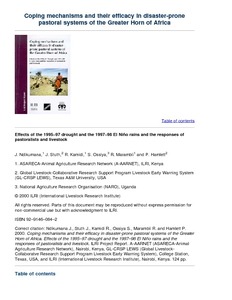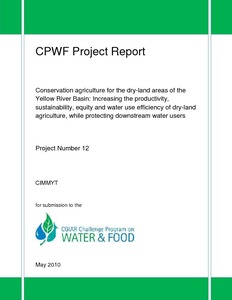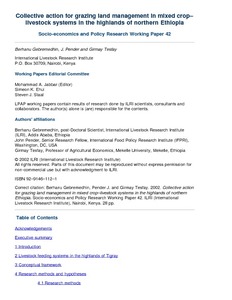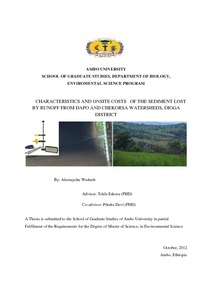système d'exploitation agricole
AGROVOC URI:
Conservation agriculture for the dry-land areas of the Yellow River Basin: Increasing the productivity, sustainability, equity and water use efficiency of dry-land agriculture, while protecting downstream water users
Soil erosion is a major problem in the Yellow River Basin: the river is one of the most
sediment-laden in the world. Although there is a rainfall gradient from 750 mm in southern
Shandong, to 200mm per year in northern Ningxia, most of the rainfed cropping area is in
regions with more than 400 mm per year – it is here that the project concentrated.
Conservation agriculture (featuring reduced or zero tillage, mulch retention, crop rotations
and cover crops) offers a possible solution to problems of soil erosion and low crop
Constraints to the development, operation and maintenance of spate irrigation schemes in Ethiopia
Flood-based farming is among the potential options in ensuring access to water for crop and livestock production for small-scale farmers in the arid and semiarid lowlands of sub-Saharan Africa, and Ethiopia in particular. Flood-based irrigation while inexpensive is rooted in tradition in many rural communities which is in contrast to many other irrigation types which are unavailable (in terms of water source, technology or capacity) or are costly to develop.
Competitive farming strategies and their effect on water provision and profitability among smallholder farms: the case of Muooni Dam site, Kenya
Conditions for collective action: Understanding factors supporting and constraining community-based fish culture in Bangladesh, Cambodia and Vietnam
Flood-prone ecosystems in South and Southeast Asia are traditionally farmed with deepwater rice followed by post-flood rice culture during the dry season. During the
flood season, the same land is inundated, creating an open-access water body subject to multiple uses by multiple users. Fish production in these areas is based on
Commune agroecosystem analysis to support decision making for water allocation for fisheries and agriculture in the Tonle Sap wetland system
The Project on Commune Agroecosystem Analysis to Support Decision Making for Water Allocation
for Fisheries and Agriculture in the Tonle Sap Wetland System was undertaken with the aim of
improving fisheries considerations in the Commune Agroecosystem Analysis (CAEA) process
undertaken in Cambodia, to facilitate better planning at the commune level. Under this project a
number of changes were made to the CAEA tools and process and pilot tested in an adaptive,
iterative manner in four communes – two that had conducted a CAEA previously and two that had
Commercializing smallholder value chains for goats in Mozambique: A system dynamics approach
Goat producers in Inhassoro follow traditional management practices that lead to low supply of low quality goats. This has negative impacts on profitability, and on market access. Traders who buy in the Inhassoro locality buy only small volumes, and buyers from external markets are unaware of potential market supply in Inhassoro. This interaction of production constraints and limited information flows in the value chain was addressed using a system dynamics model for various commercialization scenarios.
Classification and description of the major farming systems incorporating ruminant livestock in West Africa
A classification of the major ruminant livestock production systems in West Africa is proposed. The proposed typology has two major classes of systems-sole livestock and crop-livestock. The sole livestock class has two systems (rangeland-based and landless) and the crop-livestock class has three sub-classes (annual crop-livestock, tree-crop-livestock and irrigated/flooded cropland-livestock). Within the 3 crop-livestock subclasses 13 systems defined by the dominant crops are identified.
Characteristics and onsite costs of the sediment lost by runoff from Dapo and Chekorsa Watersheds, Digga District
This study conducted in two sub catchments of the Abay Basin identified the quantity and quality of sediment loss and its origin though most studies conducted in Ethiopia focus on quantification of soil loss. Also, the onsite economic cost in terms of yield reduction was estimated taking maize (Zea mays) as representative crop. For this purpose, two monitoring stations were selected at the outlet of the two watersheds. Depth integrated runoff samples were collected during the rainy season in 2011 while discharge of the Rivers was estimated from staff gauge-discharge relationship.
Characteristics of urban and peri-urban agriculture in West Africa: results of an exploratory survey conducted in Tamale (Ghana) and Ouagadougou (Burkina Faso)
The report summarizes key results from surveys carried out on urban and peri-urban agriculture (UPA) in Tamale (Ghana) and Ouagadougou (Burkina Faso) in 2013. The aim was to provide a broad overview of the state of UPA in the study cities and a basis for future research endeavors. The randomized sampling approach used aerial photography to identify 10 sites in different categories of farm in each city. Farmers provided information on their cropping and livestock-rearing activities.








